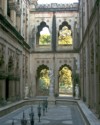 |
 |
 |
 |
Photo Collection
Places
India
Baroda (Vadodara)
Sri Aurobindo lived here from February 1893 till June 1906
Maps
Photos
Khasirao Jadhav House, Baroda
Baroda Palaces
 |
Indumati Palace of Sayajerao Gaekvar, Baroda Palace of Maharaja of Baroda, where Sri Aurobindo worked |
 |
built in 1890 by Maharaja Sayajirao Gaekwar III |
 |
Library at Lakshmi Vilas Palace 1895 |
 |
built in 1890 by Maharaja Sayajirao Gaekwar III |
Baroda College
Majumdars house, Baroda
Varia
Baroda is situated on the banks of the river Vishwamitri (whose name is derived from the great saint Rishi Vishwamitra). Vadodara district occupies 3,007 sq mi (7,788 sq km), extending from the Narmada River (south) to the Mahi River (north).
The earliest record of the city is in a grant or charter of AD 812 that mentions it as Vadapadraka, a hamlet attached to the town of Ankottaka. In the 10th century Vadapadraka displaced Ankottaka as the urban centre. It seems also to have been known as Chandanavati, after Raja Chandan of the Dor Rajputs, who wrested it from the Jainas. Then it was renamed as Varavati, Vatpatraka, Vadpatra because of the abundance of banyan trees on the banks of the Vishwamitri. From Vadpatra it derived its name Baroda, and, in 1971, Vadodara.
The history of Vadodara falls into a Hindu period (until 1297); a period under the Muslim Delhi sultanate (1297-c. 1401); an independent Gujarat sultanate, during which the nucleus of the present city was built (c. 1401-c. 1573); a Mughal Empire period (c. 1573-1734); and a Maratha period, during which it became the capital of the powerful Gaekwar family (1734-1947). In 1802 the British established a residency in the city to conduct relations between the East India Company and the Gaekwars; later it was also responsible for British relations with all the states of Gujarat and the Kathiawar Peninsula.
Baroda was the capital of one of the most powerful princely state prior to independence. City, administrative headquarters of Vadodara district, east central Gujarat state, west central India, on the Vishvamitra River, southeast of Ahmadabad.
The long history of Vadodara is reflected in its many palaces, gates, parks, and avenues. It houses the Maharaja Sayajirao University of Baroda (1949) and other educational and cultural institutions, including several museums. Among the city's varied products are cotton textiles and homespun cloth, chemicals, matches, machinery, and furniture. Vadodara is a rail and highway junction and has an airfield. Now it is a pleasant, medium sized city with some interesting museums and art galleries and a fine park etc.